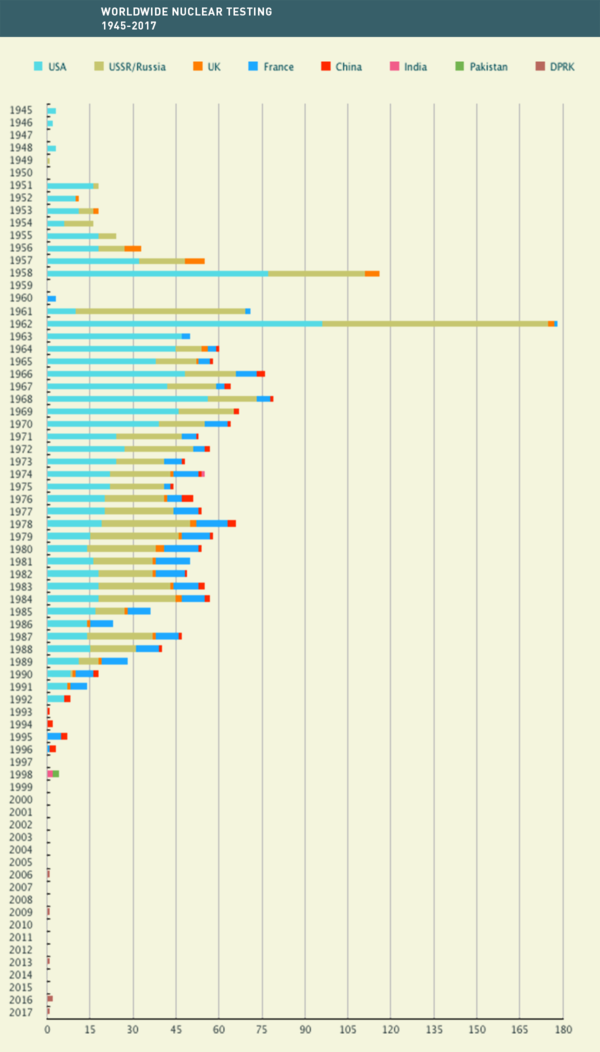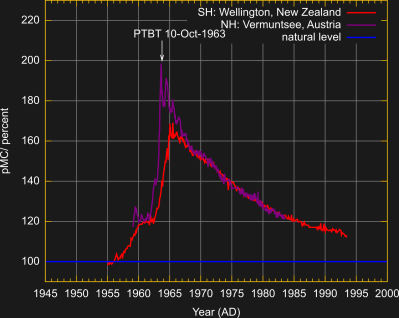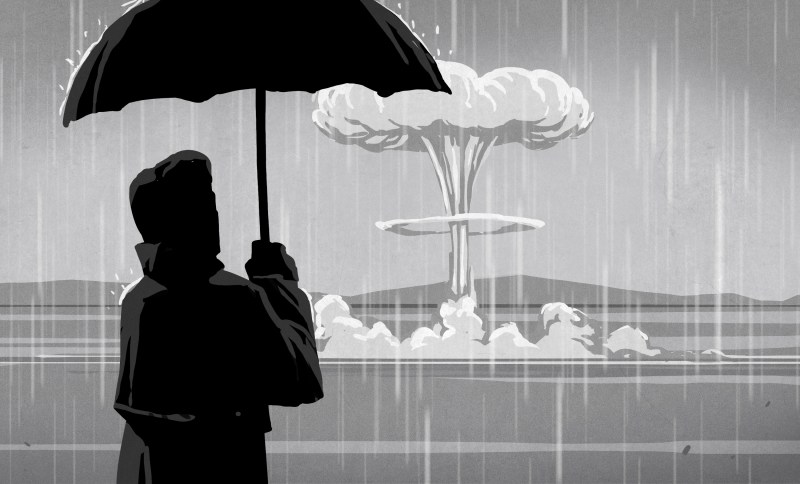Current global events have demonstrated that we do not live in the most stable of times. Still, most of us 90’s kids are probably glad that we did not have to endure the political shakiness of the Cold War era when people were living in constant fear of nuclear Armageddon. Nuclear weapons tests were common during this period as the United States and the Soviet Union invested heavily to increase the quality and quantity of their warheads in the race for nuclear supremacy.
Even though the political situation stabilized after the fall of the Soviet Union, the consequences of the vast amount of nuclear tests conducted back then are still noticeable today. Besides the devastating effects on human health and the environment, this period also leaves some implications for science which are not always negative.
A Not So Brief History of Nuclear Testing

Credit: CT24BTO
The first nuclear test was famously conducted under the codename Trinity by the United States in July 1945 as part of the Manhattan Project. The second country to follow was the Soviet Union in 1949, then the UK in 1952, France in 1960, and China in 1964. This was followed by countries like India, Pakistan, and most recently North Korea. In total over 2,100 nuclear tests have been carried out until today with an estimated total yield of about 540 megatons. The majority of these tests were carried out by the Soviet Union and the United States during the Cold War with as many as 178 nuclear explosions in the year 1962 alone.
In 1963, after having exploded hundreds of nuclear bombs above ground for the past 18 years, politicians finally concluded that they were done poisoning the atmosphere with radioactivity and ratified the Partial Test Ban Treaty (PTBT). Since then, all forms of nuclear tests were prohibited except for those conducted underground. This underground testing was only banned in 1996 by the Comprehensive Nuclear-Test-Ban Treaty (CTBT), which finally prohibits all nuclear explosions on Earth.
A nuclear explosion produces a vast amount of radioactive isotopes. These are either direct fission products or originate from the activation of other materials by thermal neutrons. In atmospheric tests, the radioactive material is propelled into the upper atmosphere before it comes down as nuclear fallout. The table below shows some of the radionuclides produced by nuclear testing that have an implication for scientific research.
| Isotope | Half-life | Origin |
|---|---|---|
| Co-60 | 5 years | activation |
| Kr-85 | 10.8 years | fission |
| Sr-90 | 29 years | fission |
| Cs-137 | 30 years | fission |
| C-14 | 5,700 years | activation |
Bomb Pulse Dating

Credit: Hokanomono
An interesting example of a radionuclide is C-14 which is also naturally produced in the atmosphere when neutrons generated by cosmic rays get absorbed by nitrogen atoms. The C-14 then combines with oxygen to form radioactive CO2.
Since a nuclear explosion floods the atmosphere with thermal neutrons it also generates C-14 through the same mechanism. As this figure shows, the C-14 concentration in the northern hemisphere was almost doubled by nuclear testing until the PTBT was signed. Luckily, the artificially produced C-14 poses no health risk and has a useful application in radiocarbon dating. Classical radiocarbon dating only works for very old organic materials since it is built on the principle that the C-14/C-12 ratio slowly decreases according to the C-14 half-life after an organism has died. Bomb pulse dating instead looks at biological samples from the nuclear testing era and compares their amount of C-14 with the decreasing atmospheric abundance of the bomb pulse. With this method, it has been possible to determine the age of unidentified bodies and study the regeneration of neuronal cells.
Detecting Fake Wine with Cs-137

Credit: CENBG
A similar dating method exists for Cs-137, an isotope that poses one of the greatest health risks of all fallout products due to its long half-life and chemical properties. Cs-137 is almost purely man-made and can be found in trace amounts in soil, plants, and animals all around the world where it has been distributed by nuclear weapons and accidents. As Cs-137 emits gamma-rays that can penetrate closed containers it can be detected non-destructively and has been used to identify the authenticity of wine bottles. Obviously, a wine which has been bottled before 1945 should not contain any Cs-137. Older wines can be dated by comparing their activity with the reference curve shown on the left.
Man-made Radioactivity Obscures Dark Matter Signal
The radioisotopes generated by nuclear testing did not all benefit Science. For some fields in physics, like the search for dark matter, the detection of neutrinos, or the search for rare nuclear decays, the unwanted background radiation from our legacy of nuclear testing gets in the way.
The XENON-1T/nT experiment, for example, is aiming at the detection of dark matter using a giant detector filled with liquid xenon. Commercially available xenon contains trace amounts of krypton at the ppm level and therefore also the fission product Kr-85. As the signal from the beta decay of Kr-85 interferes with the potential dark matter signal, the xenon first has to be purified to sub ppt levels with a special two-story-high distillation column. Another pesty background for rare event searches comes from Co-60 present in post-World War II steel. Before a detector is built one usually conducts extensive screening campaigns to identify steel with low Co-60 contamination, know as low background steel.
Nuclear Explosions Increase Rainfall
Researchers recently showed that nuclear weapon tests also had a significant influence on the distribution of rainfall. For their study, they were looking at weather data between 1962-64 from research stations in Scotland and the UK. It was shown that the Sr-90 released into the atmosphere during nuclear weapons tests significantly increased the air conductivity through ionization. The excess charge encouraged the formation of raindrops and lead to visibly thicker clouds and an average increase in rainfall of 24% on days with higher radioactivity. These findings help to better understand the role of electric charge in cloud formation with possible future applications in geoengineering.
The period of heavy nuclear testing certainly left their mark on our world. Naturally, we should not put scientists again in the situation where they try to find the silver lining in having the earth radioactively contaminated.

















When I see the byline for this article, I wonder who was victorious in the battle to decide the final content,
Moritz, or Sivers?
I believe the case of Moritz v. Sivers was used to set precedent in the case of FInders v. Keepers.
The C-14 atmospheric concentration graph is misleading because of how the Y axis is labelled. On a first glance, it looks like the C-14 concentrations flew through the roof because of the nuclear testing. You need to read the Y axis labels to see that the actual difference is just 1.5 to 2 times the natural amount.
The Old Shifted Baseline trick!
Thanks for pointing it out.
Which ‘devastating effects on human health’ are you talking about? The ones that pale into insignificance when compared with asbestos, lead, POPs, and tobacco smoke, etc.?
I think the prevalence of asbestos and smoking acted as a very convenient fall guy to take most of the cancer blame from nuke testing. Not saying they don’t cause it, just that their 100s of thousands of cases provided a very large rug to sweep radiation caused cancers under.
And Covid-19 is just a cover for lamp-post mounted 5G death rays.. ;)
Noble gas-lighting.
However a lot of the actors and acrtress who made westerns which were downwind of the test grounds and that is above ground tests, for those things have now died of radation caused cancer. All except the Duke, he developed all sorts of complications from smoking in general.
Not a western, but in particular… https://en.wikipedia.org/wiki/The_Conqueror_(1956_film)#Production_and_cancer_controversy
Radon has much more influence on cancer rates. It’s the second leading cause of lung cancer in the US. Only smoking causes more.
And interestingly enough, radon gas is a natural source of environmental lead. It moves through cracks in the soil, collects into wells and basements, and then slowly decays into lead.
A very large study county-by-county in the US actually showed an inverse relationship between radon levels and lung cancer, suggesting a hormetic affect of radon – except among smokers.
Or it might be that counties with high radon levels, they’ve been ventilating spaces better and minding the exposure, whereas in countries with no identified problems the houses lack any special measures to deal with it and people get exposed more.
So if there is no radon, it’s more of a problem? Makey no sensey.
There’s nowhere that has “no radon”. It’s just not identified as a problem where the concentrations are typically small, so there’s no building codes to deal with it and no standard testing to discover if you have any.
So people then build houses on radon hot spots, don’t know and don’t care, and then get cancer.
“… the political situation stabilized after the fall of the Soviet Union”
No, not really.
Explain yiourself please?
I’m not Miroslav but,
Would you call the current world stage stable? US v. China v. Russia v. Europe (and everything in between?)
Things stabilized a bit compared to the previous US v. USSR situation but saying the situation stabilized is a bit of a stretch imho
There was a stable period, mid 90’s, but it’s going in the other direction again.
Russia OKs Use of Nukes in Response to Non-Nuclear Attacks
https://www.courthousenews.com/russia-oks-use-of-nukes-in-response-to-non-nuclear-attacks/
Vladimir Putin endorses nuclear doctrine allowing for first strike
https://news.yahoo.com/vladimir-putin-endorses-nuclear-doctrine-162029878.html
Russia’s Vladimir Putin endorses policy allowing nuclear retaliation against conventional attack
https://www.scmp.com/news/world/russia-central-asia/article/3087253/russias-vladimir-putin-endorses-policy-allowing
After USSR collapsed, certain country believed that they are the only superpower left, and started spreading “freedom and democracy” by various measures which caused endless wars and millions of deaths.
If that is stability, please bring back the Cold War.
Complete nonsense.
https://en.wikipedia.org/wiki/Wolfowitz_Doctrine
If we’re honest about history, those things were happening before the collapse of the USSR, at a greater rate, and perpetrated by countries on both sides of the iron curtain. Seems like Russia is sick of missing out on the fun, so they’ve been back at it too.
You can argue that.
However, before we had balance of power in most conflicts. USSR helped Vietnam, USA helped Mujahedeen, etc.
For almost 30 years after 1990 there was no balance, which caused dangerous adventurism by some people in US circles of power. 17 years in god forsaken hills of central Asia, for example, proves that. What was achieved?
There never was a balance of power, just a temporary dynamic equilibrium.
Sunken ships recovered steel is used for places that need to measure radiation because another problem is the tiny but detectable trace radiation in post-WW2/test steel.
Raise the titanic to get non-radioactive steel.
https://en.m.wikipedia.org/wiki/Low-background_steel
They’ve been raising/looting war graves so far (2 dutch warships in the Java Sea have almost completely disappeared for instance)
See: https://www.theguardian.com/world/ng-interactive/2017/nov/03/worlds-biggest-grave-robbery-asias-disappearing-ww2-shipwrecks
You have the half life of Cs-137 as 30 years. Since the last aboveground test was in 1963, 57 years ago, nearly two half-lives ago, the amount of the isotope should be close to only 25% of what the last aboveground detonations put out, and less remaining from earlier detonations.
Cobalt-60 has a half life of 5.7 years so there should only be a tiny fraction of it left from aboveground detonations.
Same goes for all the rest of the short half-life radioactive isotopes.
For radioactivity danger, in general the longer the half life, the less the danger because spewing out a lot of radiation means it’s decaying faster. It also matters if it’s an alpha (helium nucleus), beta (electron), gamma (ray), or neutron emitter.
Alpha particles are no big deal as long at you don’t eat or breathe them in. That’s why Radon gas is a problem.
A long half life neutron emitter is pretty nasty because it can do a little damage over a long period of time. A short half life alpha emitter can be left alone, just don’t do something stupid like licking it or swallowing it if it’s small enough.
Four radioactive cookies, one emitting each type of radiation. Eat one, hold one in a hand, put one in a pocket, throw one away.
I was able to take advantage of nuke tests for a bit of high school science:
In the Mid ’70s, I built a seismometer and a system to modulate the output on to an audio frequency carrier, to be recorded on cassette tape. By 1977 or so, I had two such setups and was playing the tapes back into my IMSAI 8080 and doing FFTs to see events in the frequency domain.
My Dad suggested that we take one to the top of a 20 story building that he had access to and record the same event there and at home, expecting to see the building resonate and act as a bandpass filter. To do this without leaving the equipment in the building for months, and build a second auto-start circuit for the tape recorder, we needed a seismic event at a known future time.
How do you predict an earthquake? Well, the schedule for the atomic tests was announced in the newspaper!
The underground bomb went off right on schedule and the results clearly showed the building resonating.
BTW, about half of the tests were announced in advance. It seems silly to keep the others secret, when a high school student in Los Angeles can clearly tell that they set off a bomb in Nevada!
Cool project, and it’s interesting that some, but not all tests were posted. As you say, it’s unlikely that any party who wanted to know didn’t know.
What happened in 1959 & 1960 (& 1961 for the US) that caused the dramatic fall in the number of tests?
Is that just a hole in the data?
Nevermind. I found the answer.
This is taken from [votes] answer on stack exchange:
The reason there were no tests in 1959 was that the Soviet Union, Great Britain, and the United States agreed to a moratorium on nuclear weapon tests in 1958. This moratorium lasted from November 1958 to August 1961. The Soviet Union resumed on 1 September, 1961, with the US following suit a couple of weeks later.
France, being on the verge of being a nuclear-capable nation in 1958, did not take part in that moratorium. They didn’t test in 1959 because they did not quite have the ability to do so. They did have that ability in 1960.
https://history.stackexchange.com/questions/35029/why-were-there-no-nuclear-detonations-in-1959